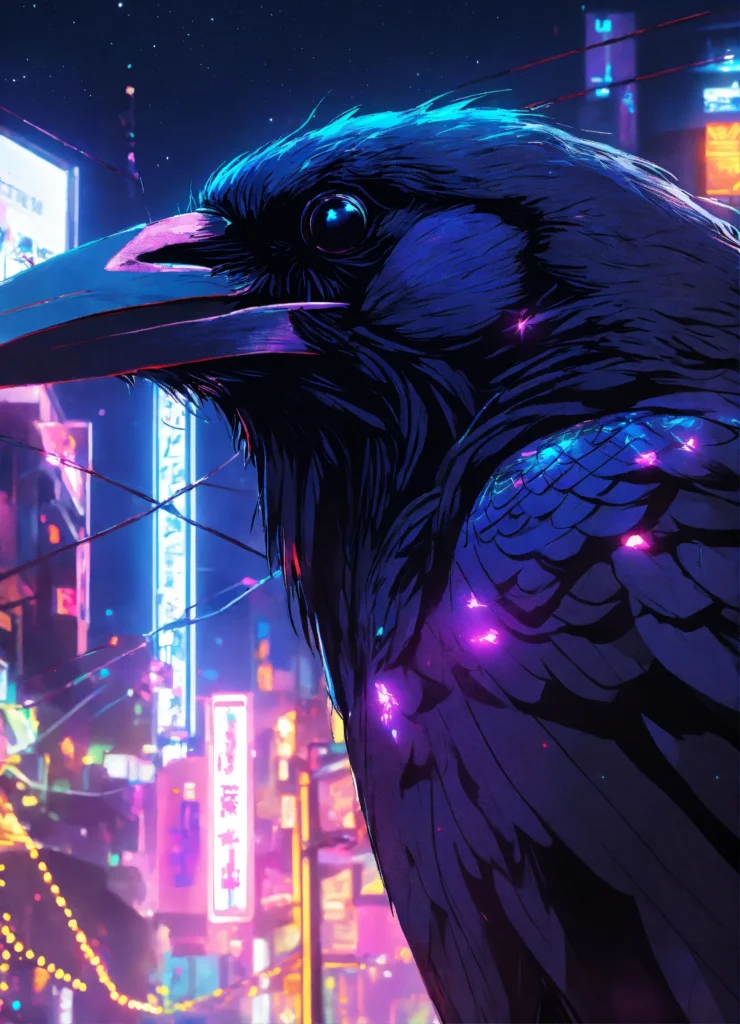
The village of Murk Hollow nestled in a perpetual twilight, cradled by hills that clawed at a sky perpetually bruised purple. The air tasted of damp earth and something acrid, like burnt offerings left too long on a forgotten altar. The villagers, gnarled and stooped like ancient trees, lived under the shadow of the Carrion Crow, a being whispered about in hushed tones, a creature of nightmare woven into the very fabric of their existence.
The Crow, they said, was not a bird, not entirely. It was a construct, a grotesque parody of life animated by a clockwork heart, powered by the grief and despair of Murk Hollow itself. Its feathers were shards of obsidian glass, its eyes burning embers that saw through skin and bone, straight to the marrow of the soul. Its beak, a rusted iron contraption, clicked and whirred as it spoke, its voice a rasping whisper that promised only pain.
Old Man Hemlock, the village elder, claimed to have seen the Crow’s creation. He spoke of a toymaker, a man named Silas who arrived in Murk Hollow generations ago, his eyes gleaming with a feverish light, his hands stained with oil and soot. Silas, driven mad by the loss of his wife and child, sought to cheat death, to build a vessel to house their departed spirits. He gathered the bones of crows, scavenged scrap metal from the abandoned mines, and fueled his forge with the tears of his own unending sorrow.
He built the Crow, a magnificent, terrifying thing. But the spirits he sought were not there. Instead, he had created something else, something hungry, something that fed on the darkness that festered in Murk Hollow. Silas, realizing his monstrous creation, tried to destroy it, but the Crow was too strong, its clockwork heart beating with the relentless rhythm of despair. It silenced Silas, leaving him a broken husk, another monument to the Crow’s insatiable hunger.
Now, the Crow demanded a tithe. Every year, on the night of the blood moon, it would descend upon Murk Hollow, its shadow swallowing the village whole. It would choose one soul, a sacrifice to appease its insatiable hunger. The chosen one would be led to the Crow’s roost, a twisted tower of rusted metal and shattered glass that pierced the bruised sky. No one knew what happened within those walls, but the screams that echoed through the night were enough to curdle the blood and freeze the marrow.
This year, the lot fell upon Elara, a young woman with eyes the color of the twilight sky and hair like spun moonlight. She was the only spark of beauty left in Murk Hollow, a fragile flower blooming in a field of thorns. The villagers, hardened by years of fear and resignation, offered her hollow condolences, their eyes averted, unable to meet her gaze.
Elara, however, refused to succumb to despair. She had heard the stories of the Crow, the tales of its creation, the whispers of its clockwork heart. An idea, fragile as a butterfly’s wing, fluttered in her mind. What if the Crow could be stopped? What if its heart, the source of its power, could be silenced?
On the night of the blood moon, as the Crow descended upon Murk Hollow, its shadow stretching like a suffocating blanket, Elara stepped forward, not with fear, but with a strange, unsettling calm. She carried with her a small, intricately crafted music box, a relic from her grandmother, its melodies said to soothe even the most tormented soul.
The Crow landed before her, its obsidian feathers glinting in the blood moon’s crimson light, its rusted beak clicking impatiently. Its burning eyes bored into her, searching for the fear it craved. But Elara did not flinch.
“I know your story,” she said, her voice clear and steady, a stark contrast to the Crow’s rasping whisper. “I know of Silas, the toymaker who sought to cheat death. I know of your clockwork heart, fueled by the grief of this village.”
The Crow tilted its head, its burning eyes narrowing. “Grief is power,” it rasped. “It sustains me.”
“But grief is also a prison,” Elara countered. “A prison that keeps you bound to this darkness. You are a creature of sorrow, but you do not have to be.”
She opened the music box. A delicate melody filled the air, a song of hope and remembrance, a lament for lost love and a celebration of enduring spirit. The notes danced on the wind, weaving a tapestry of light and sound.The Crow flinched. Its obsidian feathers ruffled, its rusted beak clicked erratically. The burning embers in its eyes flickered, as if struggling to maintain their infernal glow. The music, alien and unwelcome, was disrupting the rhythm of its clockwork heart.
Elara continued to play, her fingers moving deftly across the music box’s intricate mechanism. The melody grew stronger, more insistent, pushing back the darkness that clung to the Crow. She saw a flicker of something in its eyes, something other than malice, something akin to pain.
The Crow staggered back, its clockwork heart sputtering and wheezing. It raised its iron beak in a silent scream, a desperate attempt to silence the music, to reclaim its dominion over the darkness.
But it was too late. The music had taken root, penetrating the Crow’s defenses, reaching the core of its being. The clockwork heart, once fueled by grief, began to resonate with the melody, its rhythm changing, its purpose shifting.
With a final, agonizing shriek, the Crow collapsed. Its obsidian feathers shattered, its rusted beak crumbled, and its clockwork heart, no longer able to sustain its monstrous form, ground to a halt. The darkness that had clung to it for so long dissipated, leaving behind only a pile of broken metal and shattered dreams.
The blood moon retreated behind the clouds, and a sliver of dawn broke through the perpetual twilight of Murk Hollow. The villagers emerged from their homes, their faces etched with disbelief. The reign of the Carrion Crow was over.
Elara stood amidst the wreckage, the music box silent in her hands. She had not destroyed the Crow, but she had changed it, she had silenced its hunger, she had freed it from its prison of grief.
But the darkness of Murk Hollow did not vanish overnight. The grief and despair that had fueled the Crow still lingered, woven into the very fabric of the village. The villagers would have to learn to heal, to forgive, to find light in the darkness.
And Elara, the young woman with eyes the color of the twilight sky, would be their guide. She would teach them to sing, to remember, to hope. She would show them that even in the darkest of places, even in the heart of the Carrion Crow, there was still a flicker of light waiting to be rekindled. The story serves as a chilling reminder that even the most monstrous creations can be undone, not by brute force, but by the enduring power of hope and the transformative magic of music.
However, the lingering darkness suggests that the true horror lies not in external monsters, but in the internal struggles to overcome grief and despair, hinting at a future where the villagers must confront their own demons to truly escape the shadow of the Carrion Crow.
Source: Read MoreÂ

